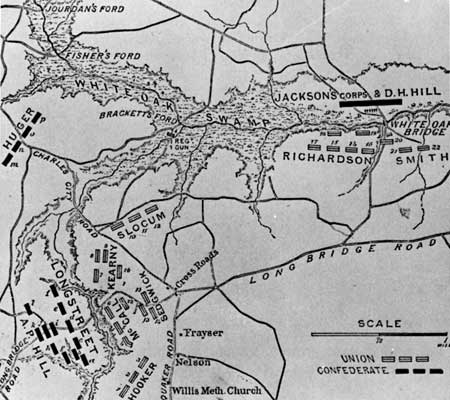|
RICHMOND National Battlefield Park |
 |
PART ONE
THE PENINSULA CAMPAIGN, SUMMER, 1862
(continued)

Battle of Glendale.
From Battles and Leaders of the
Civil War.
Glendale (Frayser's Farm)
Lee now ordered Magruder to follow Longstreet and A. P. Hill down the Darbytown road. The next day, June 30, Longstreet and Hill came upon the Union troops of McCall and Kearney across the Long Bridge road about a mile west of the Charles City road intersection at Glendale. Hooker held the left or south flank, with Slocum on the right guarding the Charles City road approach. Sedgwick was in the rear in reserve. Longstreet and Hill halted and waited for Huger, coming down the Charles City road, and Jackson, supposedly coming on the Federal rear from White Oak Swamp.
Meanwhile, Gen. T. H. Holmes, who had come from the south side of the James River with part of his division and Gen. Henry A. Wise's brigade, had been sent by Lee down the River, or New Market, road in an attempt to get between McClellan and the James River. McClellan anticipated the move, however, and Warren of Sykes' division stopped Holmes south of Malvern Hill. Lee then ordered Magruder on the Darbytown road to reinforce him, but Magruder's forces did not get there in time to help.
Huger was delayed by obstructions, mostly felled trees, with which the Federals had blocked his path. Instead of going around the obstructions, Huger continually halted to clear the road. Thus it resolved itself into a question of whether Huger could clear the trees as fast as the Union soldiers cut them down. In this so-called "battle of the axes" Huger lost, and did not get to Glendale in time to participate in the engagement.
About 4 that afternoon, however, Longstreet heard artillery firing from Huger's direction which "was supposed to indicate his approach," and expecting Jackson's appearance momentarily, he opened with one of his batteries and thus brought on the battle. Jackson never did show up, being held north of White Oak Swamp by the artillery of Richardson and Smith, and did not get to Glendale until the next day. The fight was particularly vicious with many pockets of hand-to-hand combat, but, without the expected support of Huger and Jackson, Longstreet could not break the Union lines in time to inflict any serious damage or to interrupt the withdrawal. Lee stated in his report: "Could the other commands have cooperated in the action the result would have proved most disastrous to the enemy." Gone was Lee's last chance to cut McClellan's army in two.

|

|
|
Last Modified: Mon, Mar 4 2002 10:00:00 pm PDT |


